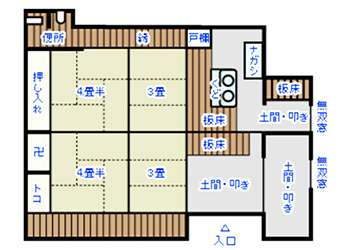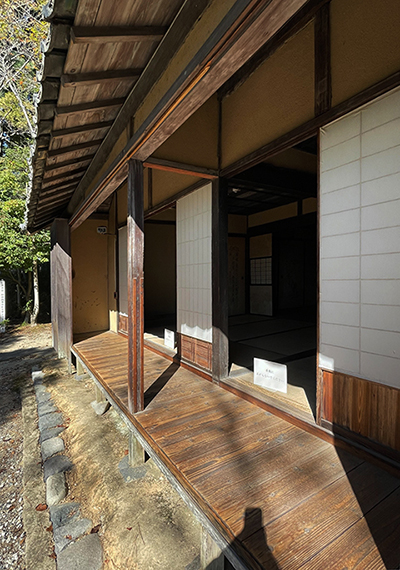


本日は連載していた「柳田國男・生家」シリーズの4回目に復帰。
兵庫県福崎町のこの家からは「松岡家5兄弟」といわれるほどそれぞれの分野で功績を残した人材が輩出されたという。先般書いたように、柳田は「日本一小さい家」とこの家屋のことを表現していたけれど、同時に民俗学に目覚めていった原点であると告白している。人間の成長に於いて家という環境がどんな影響を与えるのかについて、きわめて興味深い事実のように思われる。
もちろん「功績を残した」こと自体の冷静な検証ということは必要だろう。人の価値というものはある特定のことがらだけで論じられるべきテーマとは思われない。しかしここでは世間の一般的理解ということに即して前提として考えてみる。
たしかに、医師・政治家、眼科医・歌人、高級軍人・言語学者、日本画家、そして柳田本人の民俗学の父という業績を併置してみれば、顕彰される事跡の人びととは思える。
DNA的な優秀さというものがベースにはあるだろうけれど、常人としては「家屋の間取り」とか「空間的環境要件」というようなものにごく自然に興味は向かう。とくに住宅文化を考えてきたわたしのような人間としては、興味を惹かれるのですね。
間取りとしては図のように整形4間取りと言われる田の字型が基本であり、木材を使って建てられる住文化としてはごく自然なスタイル。日本の伝統的住文化の基本の形式。

ただ、この間取りのなかで夫婦と成人したこどもたち5人、夭折したこどもたち3人の合計10人が住み暮らしていたという「狭い家」状況を考え、柳田が「原点」と捉えた民俗・暮らしという視点も重ねて見たら、いろいろな想像力が働いてくる。
わたし的には成人したこどもたちが全員男子であったことも考え合わせると、家族間コミュニケーションの濃厚さに気付かされる。わたし自身も姉が1人であとは男子が5人という環境で育ったけれど、とくに同性の兄たちからさまざまな「経験知」が積層してくる実感が大きかった。
わたしは末っ子だけれど、兄たちが経験したことの「知恵」が先験的なものとしてさまざまに利活用できるのだ。たとえば学校の先生についての子ども視点での人物評価などは、知らず知らずに知識が積み重なっていた。「あの先生、オモシロいんだよな」「あの先生はちょっとこういう面がある」みたいな情報がバンバン伝わってくるのだ。
柳田の「狭い家」という印象の仲に、どうもそういった家族間での情報交流の濃密さが言外に含まれていると思える。お互いに情報交換を重ねていくことで、社会的ノウハウの蓄積が加速化する部分というのがあったのではないだろうか。
田の字型の間取り図と、そのウチソト的関係性をながめながら、この空間での家族同士のコミュニケーションの日常生活という部分に思いが至る。
English version⬇
The Missing Link between Folklore and Housing Culture-4
The power of “family communication” is somewhat losing its richness today. Isn’t this a theme that should be examined more consciously? …
Today we return to the fourth installment of our serialized “Kunio Yanagida: Birthplace” series.
This house in Fukusaki-cho, Hyogo Prefecture, is said to have produced five brothers of the Matsuoka family, each of whom has made significant achievements in their respective fields. As I mentioned earlier, Yanagida described the house as “the smallest house in Japan,” but he also confessed that it was the starting point of his interest in folklore. It is an interesting fact about the influence of the environment of a house on human growth.
Of course, it is necessary to examine the “achievement” itself dispassionately. The value of a person is not a topic that should be discussed in isolation. However, as a premise here, I would like to consider it in the context of the general public’s understanding.
Indeed, Yanagida’s achievements as a physician, politician, ophthalmologist, poet, high-ranking military officer, linguist, Japanese painter, and father of folklore are all worthy of recognition.
Although DNA excellence may be the basis of his work, I believe that ordinary people are naturally interested in the “layout of a house” and “spatial environmental requirements. Especially for someone like me who has been thinking about housing culture, I am very interested in it.
As shown in the figure, the basic floor plan is the tano-ji (shaped like a rice paddy field), which is a very natural style of housing culture built with lumber. This is the basic form of traditional Japanese housing culture.
However, when we consider that a total of 10 people (the couple, their five adult children, and three children who died prematurely) lived in this house, and when we also look at it from the perspective of folk customs and lifestyles, which Yanagida considered to be the “starting point” of the house, various imaginative powers come into play.
I also think of the fact that all the adult children were boys, which makes me think of the richness of communication between the family members. I myself grew up with one older sister and five other boys, and I especially felt a great sense of “experiential knowledge” from my older brothers of the same sex.
Although I am the youngest, I was able to utilize the “wisdom” of my older brothers’ experiences in a variety of a priori ways. For example, my knowledge of how to evaluate a school teacher from a child’s point of view was accumulated without my knowing it. Information such as, “That teacher is interesting,” or “That teacher has a little bit of this side to him,” was transmitted to me in rapid succession.
Yanagida’s impression of the “small house” seems to include such a dense exchange of information among the family members. The accumulation of social know-how may have been accelerated by the mutual exchange of information.
While looking at the figure of a rice field floor plan and its uchisoto relationship, I was reminded of the daily life of communication among the family members in this space.
Posted on 11月 19th, 2023 by 三木 奎吾
Filed under: 住宅マーケティング







コメントを投稿
「※誹謗中傷や、悪意のある書き込み、営利目的などのコメントを防ぐために、投稿された全てのコメントは一時的に保留されますのでご了承ください。」
You must be logged in to post a comment.